Physical Address
304 North Cardinal St.
Dorchester Center, MA 02124
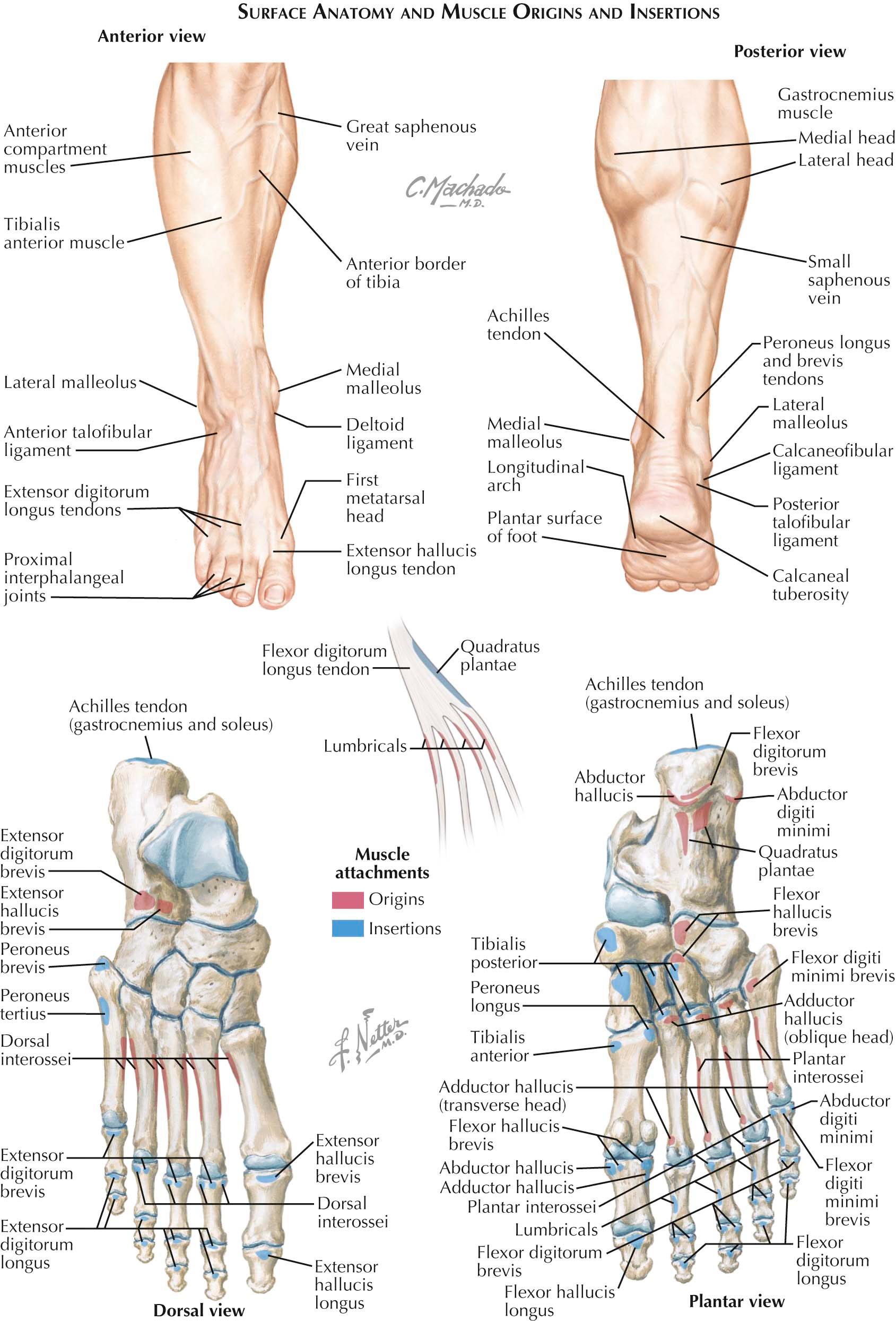
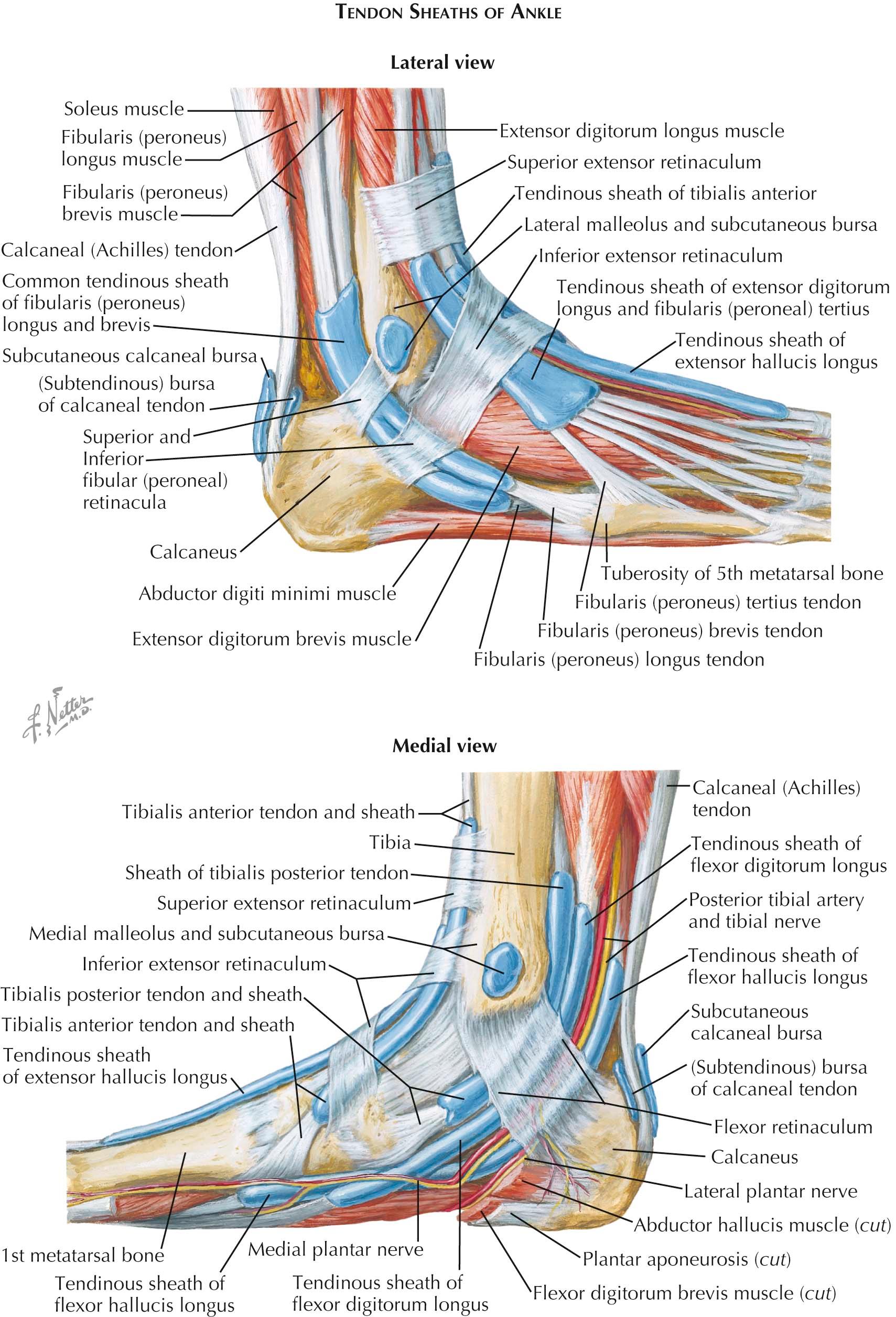
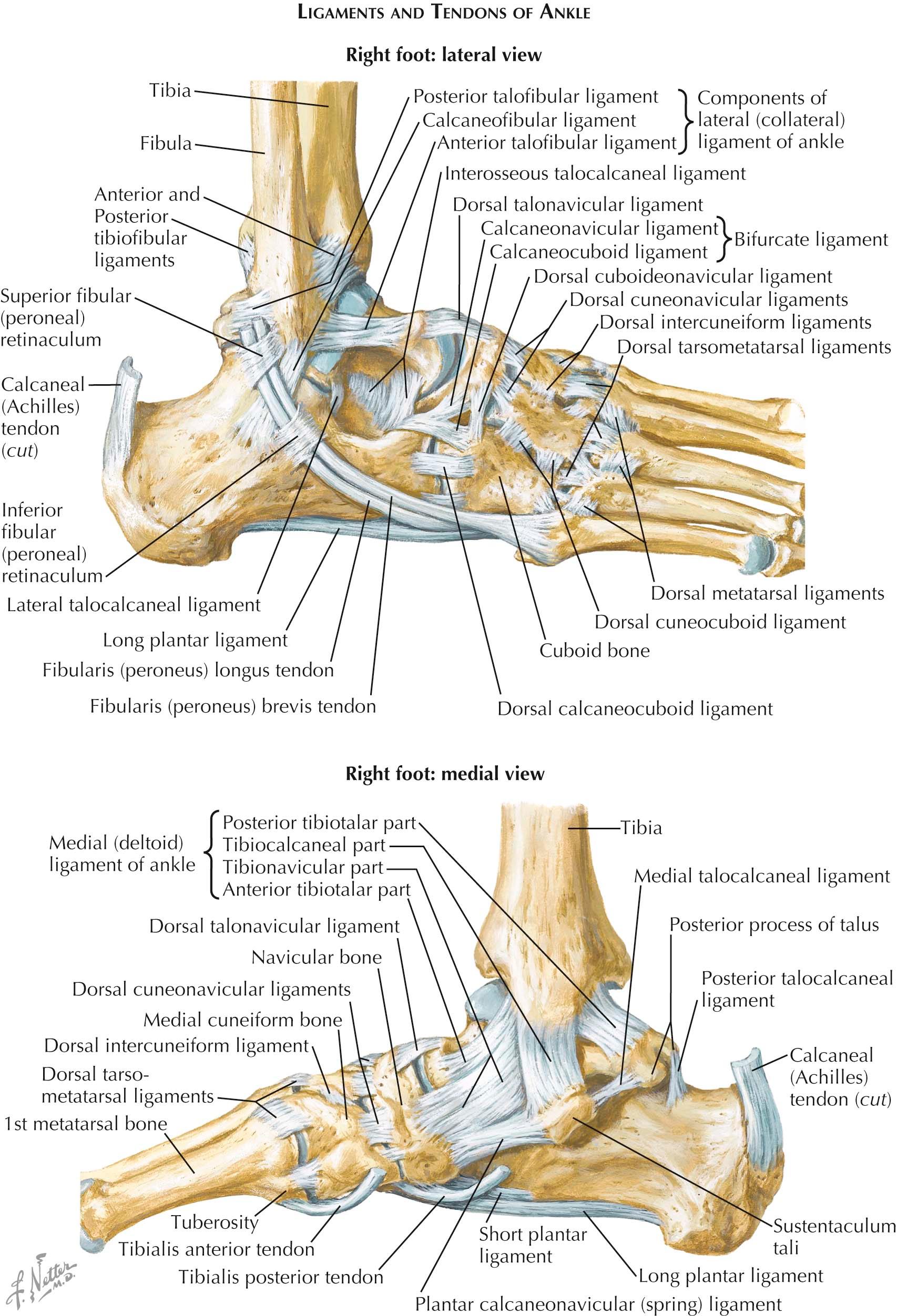
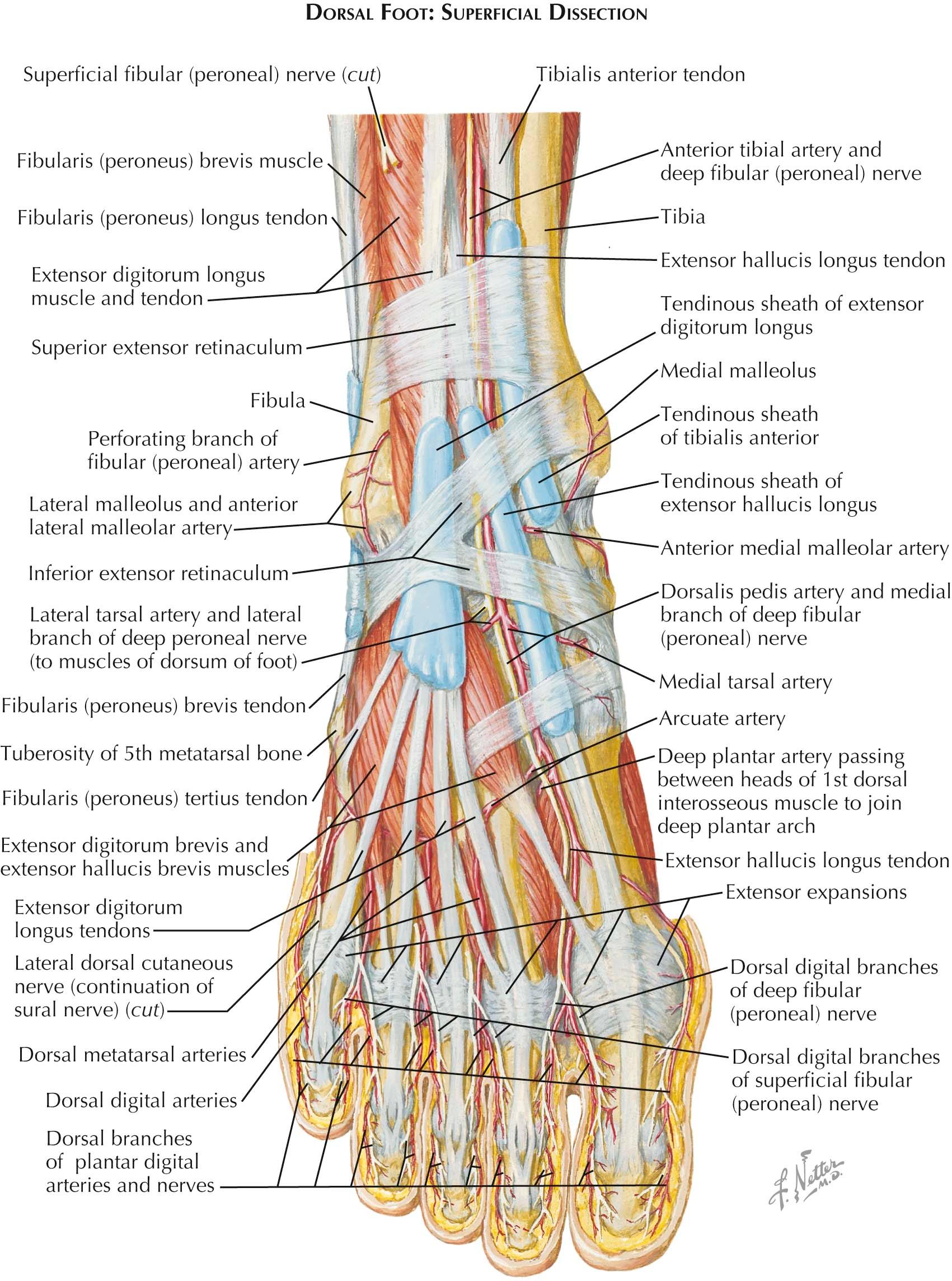
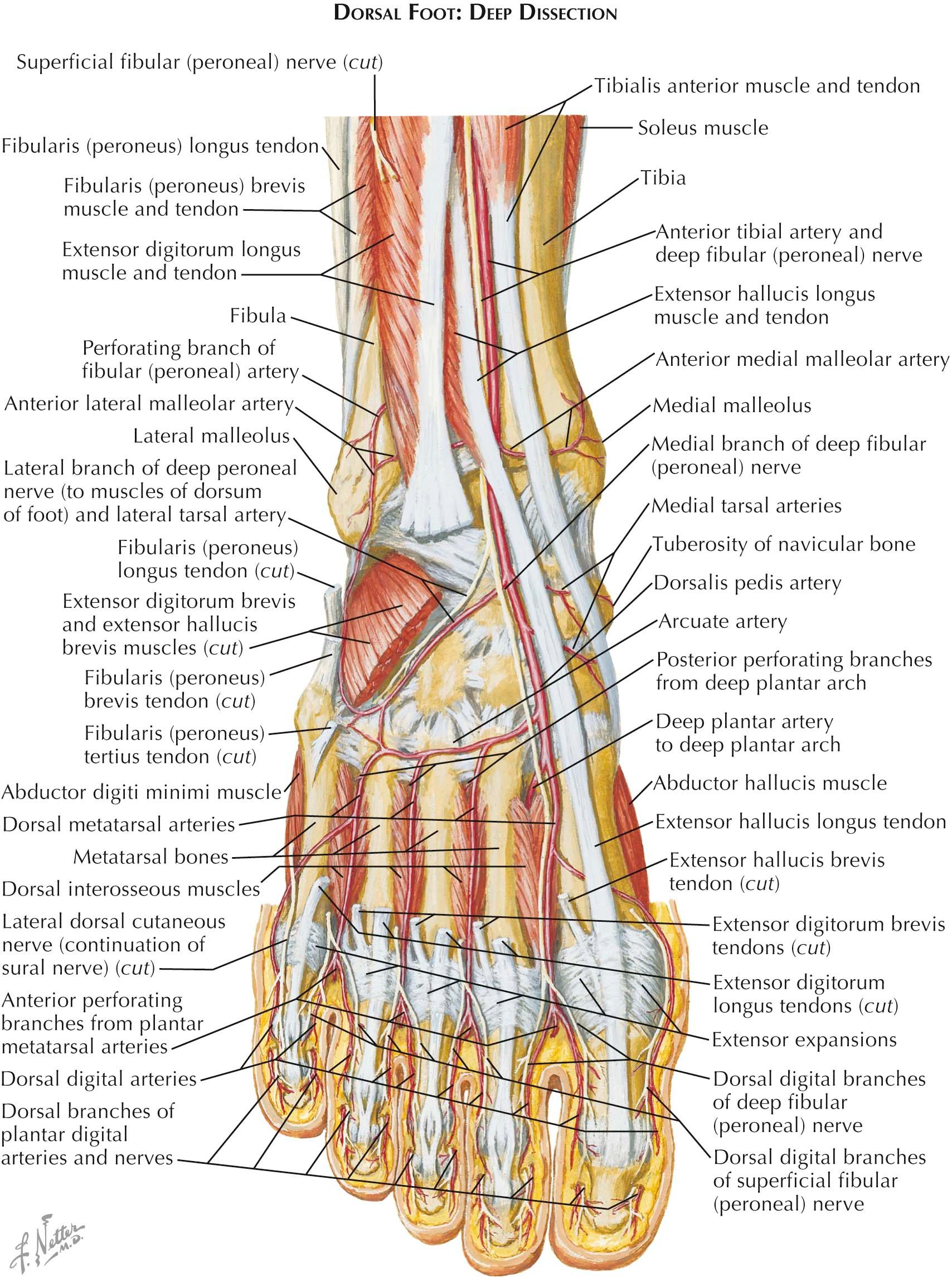
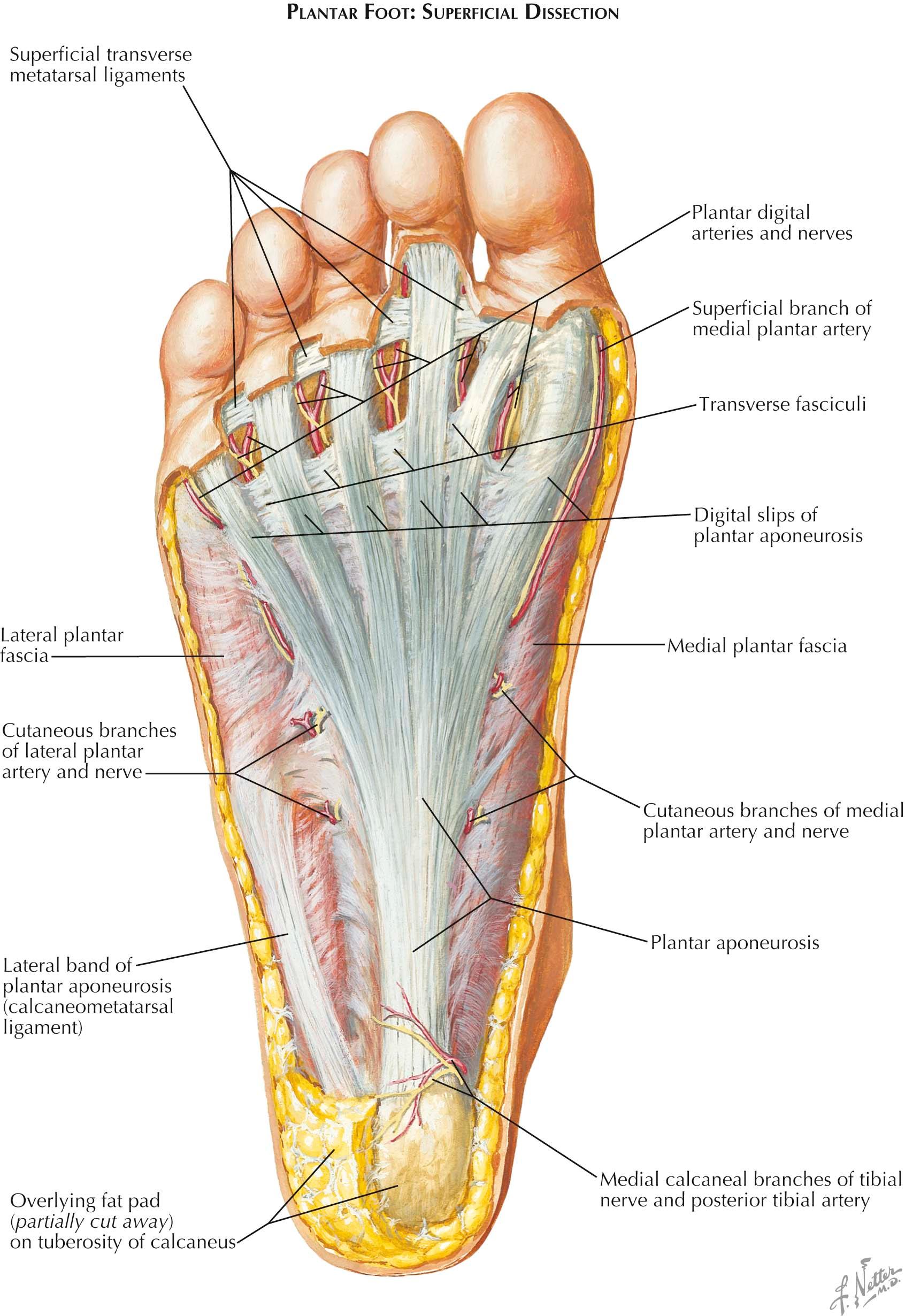
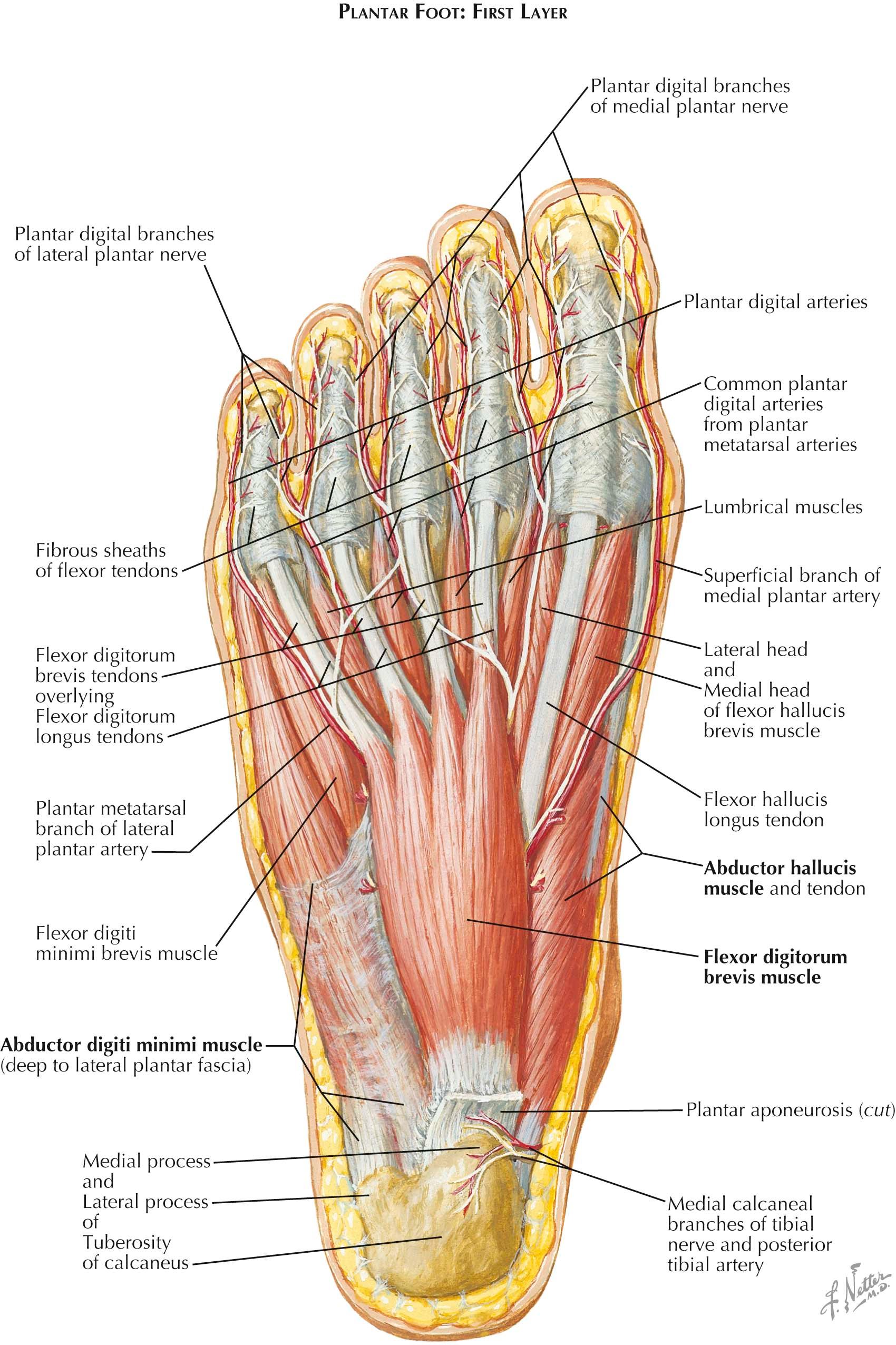
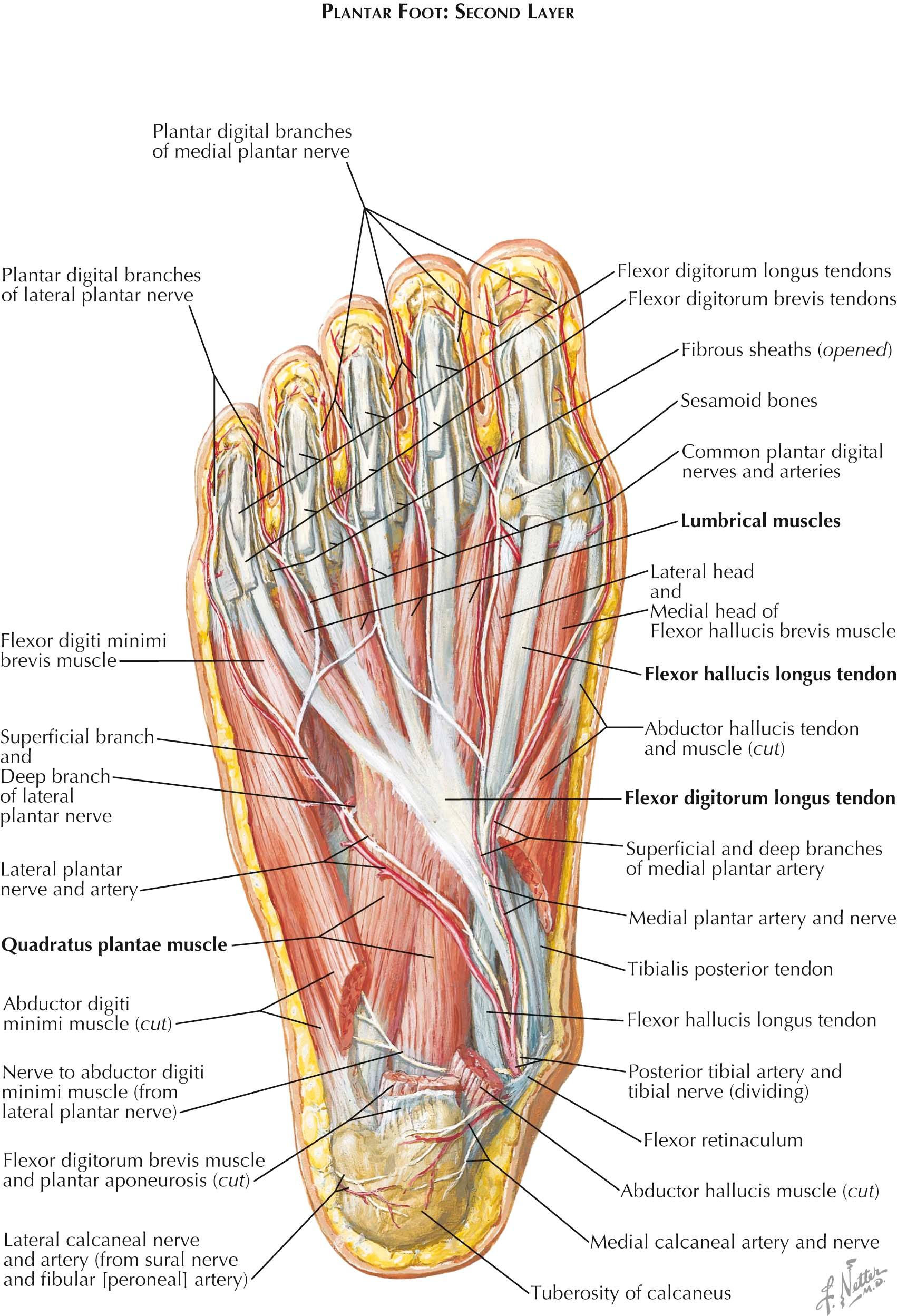
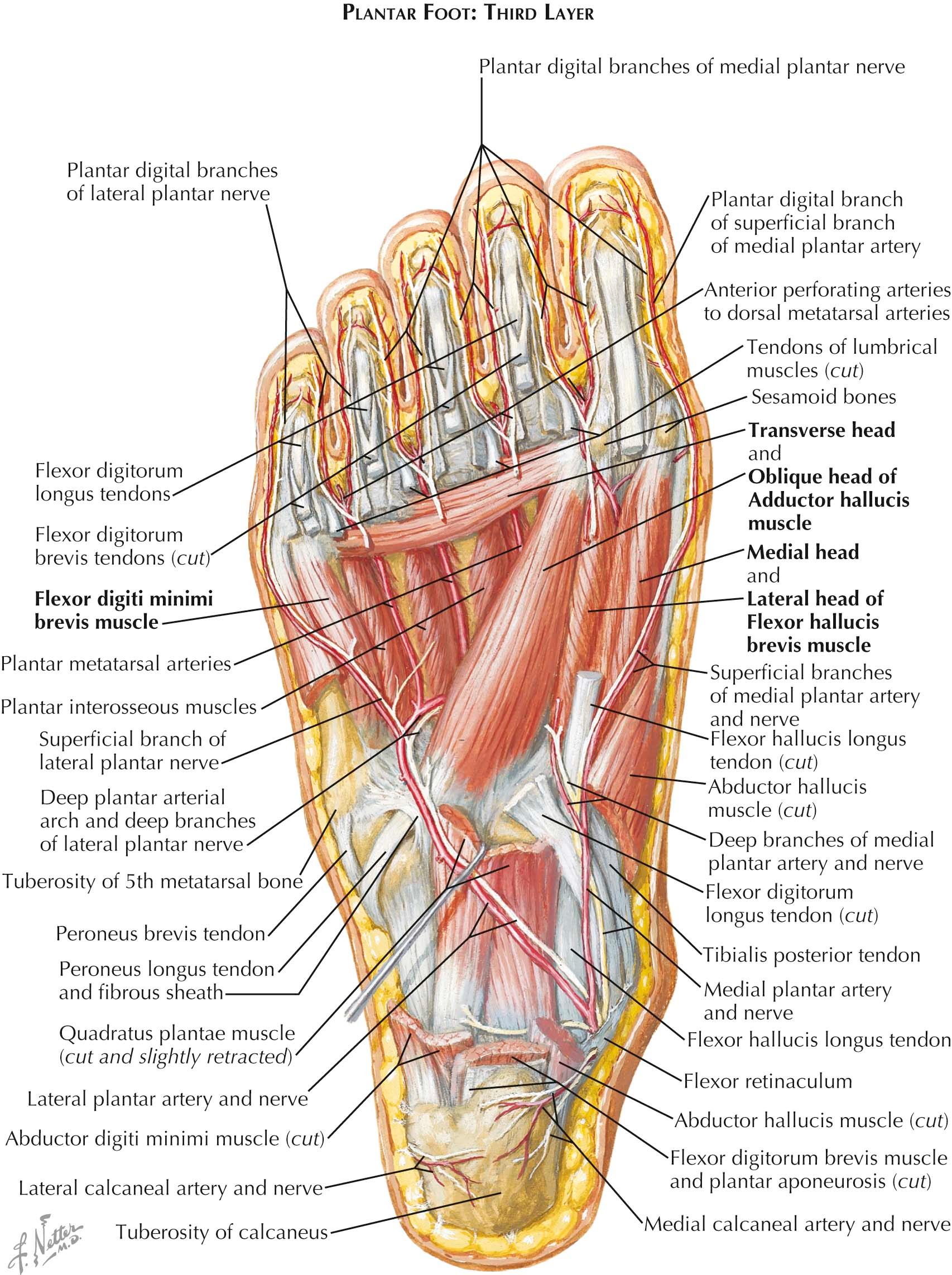
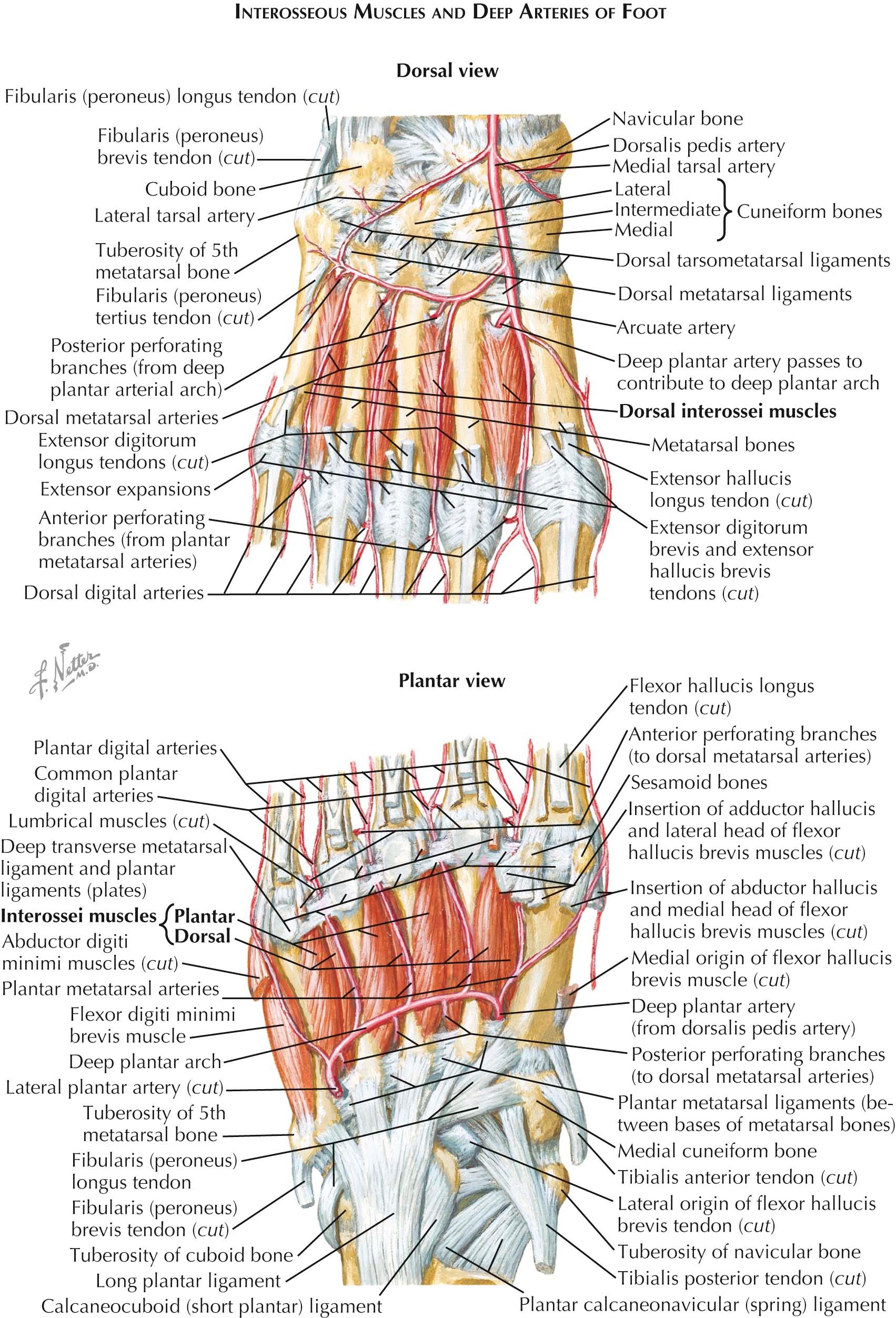
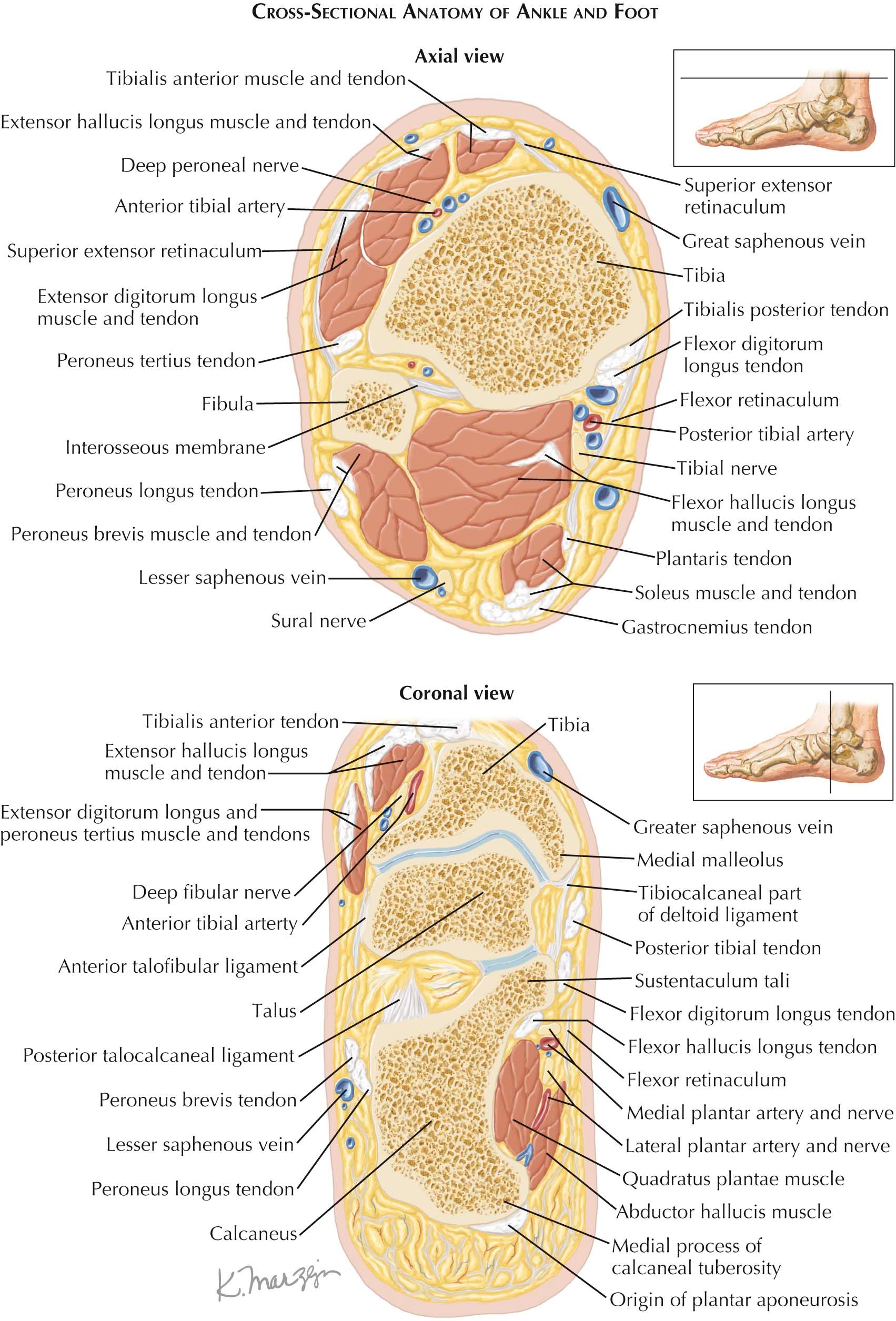
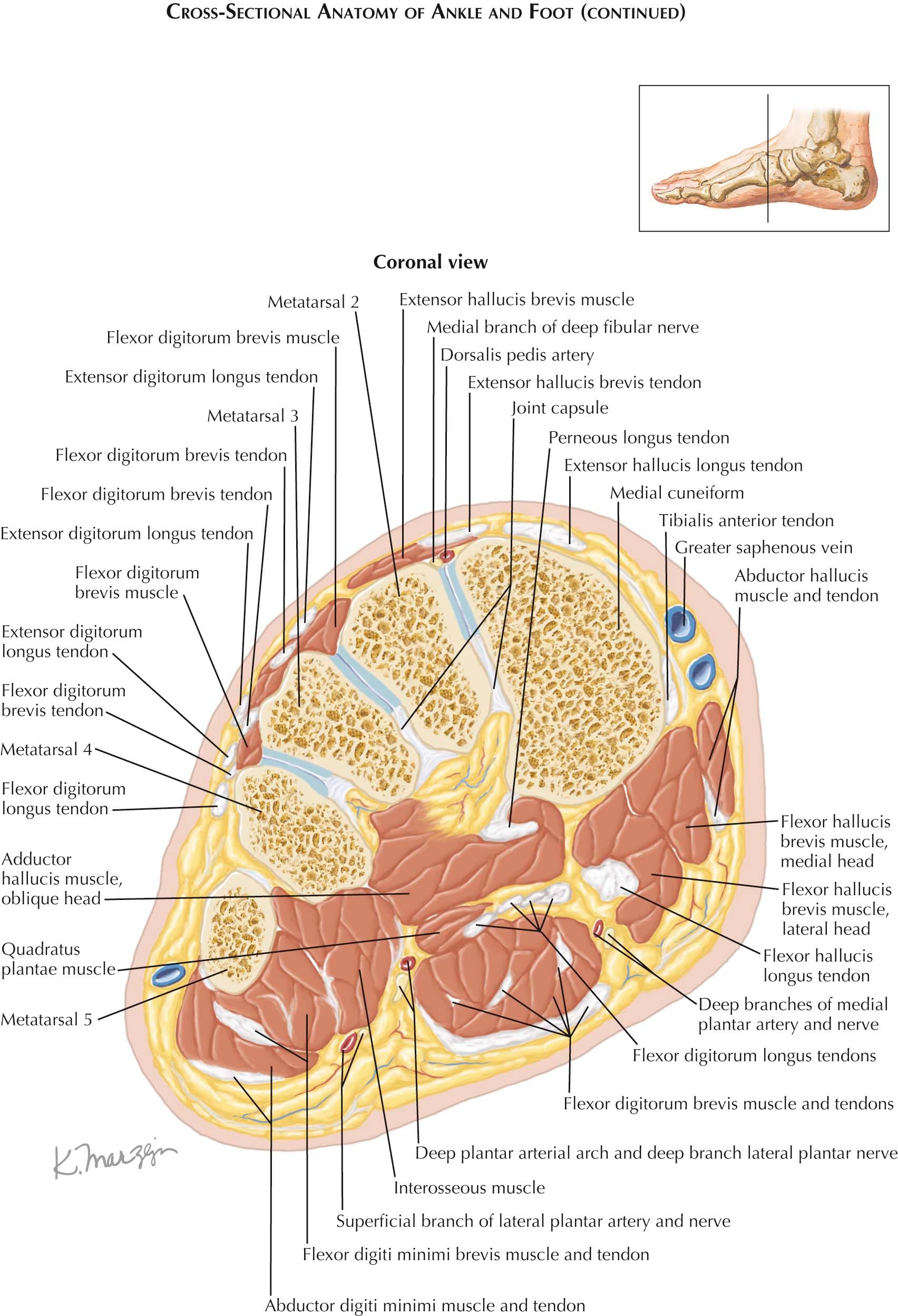
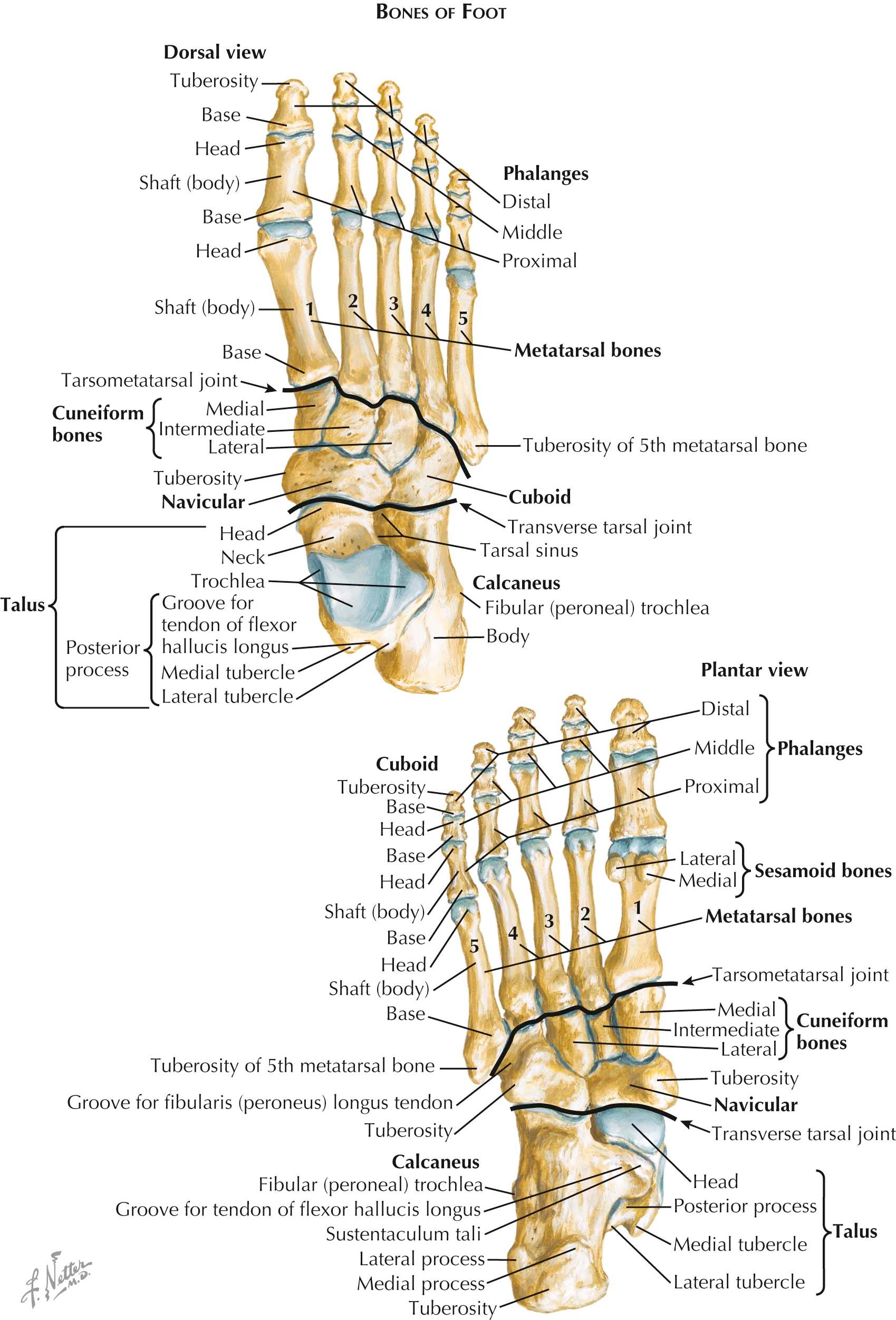
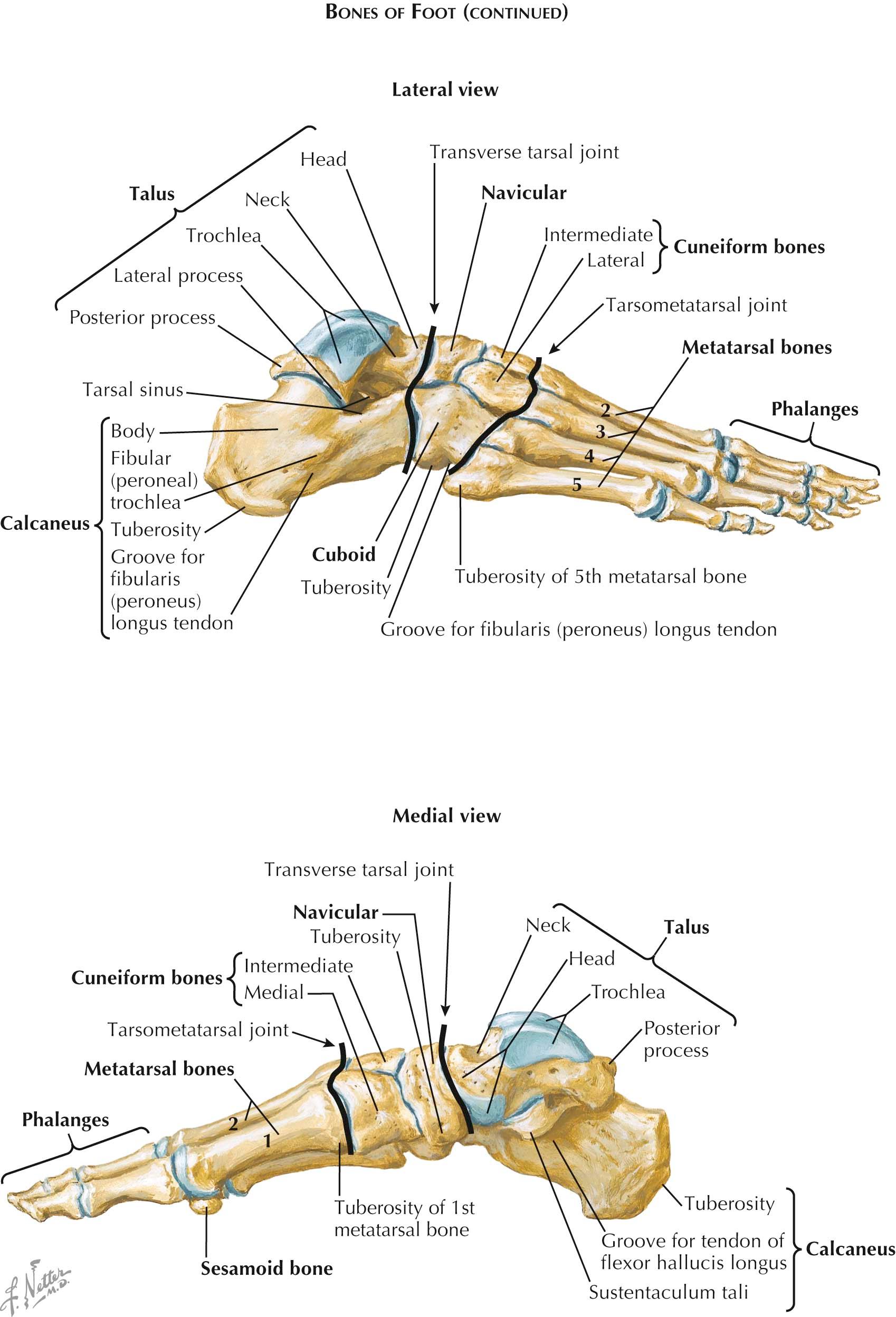
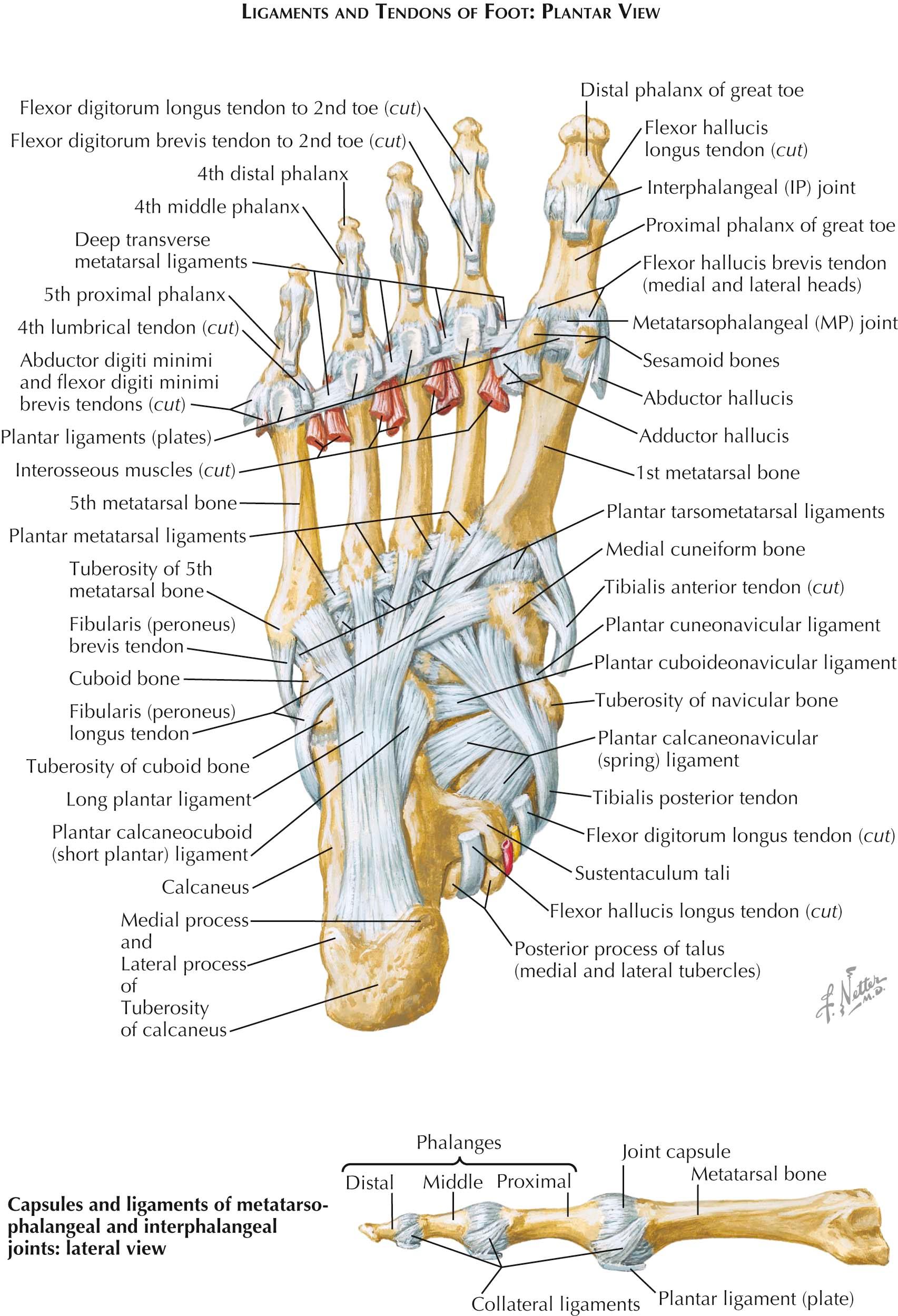
The extrinsic tendons of the foot originate as muscles in the leg, and as the tendons cross the ankle they must change their orientation. The retinaculum and the corresponding bony anatomy account for the pulley system that allows this to occur and to generate a mechanical advantage for transmission of force. The retinaculum also prevents bowstringing by holding the tendons, vessels, and nerves against the bone as they transverse the ankle joint.
The superior extensor retinaculum is a reinforcement of the crural fascia just above the ankle. It is attached laterally to the lower end of the fibula and medially to the tibia, and it covers the structure of the anterior compartment of the leg. A strong septum runs from its deep surface to the tibia, separating a medial compartment for the tendon of the tibialis anterior muscle from a lateral compartment for the tendons of the long extensor muscles.
The inferior extensor retinaculum is a well-defined, Y -shaped band overlying the dorsum of the foot and the front of the ankle. The stem of the Y arises from the upper surface of the calcaneus and is in the form of two laminae, one superficial and one deep to the tendons of the peroneus tertius and extensor digitorum longus muscles. At the medial border of the latter tendon, the two laminae merge and the limbs of the Y begin to diverge. One limb is directed upward and medialward to attach to the medial malleolus. It passes over the tendon of the extensor hallucis longus muscle, the dorsalis pedis vessels, and the deep peroneal nerve but splits to form a separate canal for the tendon of the tibialis anterior muscle. The lower limb of the Y passes medialward across the medial border of the foot and is lost in the deep fascia of the sole.
The flexor retinaculum stretches from the medial malleolus to the medial tubercle of the calcaneus. From its deep surface, septa pass to the back of the lower end of the tibia and the capsule of the ankle joint. The four canals defined by these septa transmit, beginning medially, the tendon of the tibialis posterior muscle, that of the flexor digitorum longus muscle, the posterior tibial vessels and the tibial nerve, and the tendon of the flexor hallucis longus muscle. The upper border of the flexor retinaculum is continuous with the transverse intermuscular septum. Its lower border is continuous with the deep fascia of the sole and gives origin to the fibers of the abductor hallucis muscle.
The peroneal retinacula are thickenings of the fascia on the lateral side of the ankle. The superior peroneal retinaculum extends from the lateral malleolus into the fascia of the back of the leg and to the lateral surface of the calcaneus. The inferior peroneal retinaculum is a thickening of fascia, both ends of which attach to the lateral surface of the calcaneus. It is continuous superiorly with the stem of the Y of the inferior extensor retinaculum. Deep to the peroneal retinacula pass the tendons of the peroneus longus and peroneus brevis muscles; the peroneus brevis tendon is the anterior of the two behind the medial malleolus and superior to the tendon of the peroneus longus muscle beneath the inferior peroneal retinaculum.
This tibiotalar articulation is a synovial joint of the hinge (ginglymus) type. The ankle joint appears as a mortise and tenon structure from architectural design and construction. The distal tibial plafond and medial malleolus along with the lateral malleolus from the distal fibula form the mortise for the body of the talus, which is the tenon.
The trochlea of the talus is convex from anterior to posterior and slightly concave from medial to lateral. The talar body is slightly larger anteriorly than posteriorly owing to the oblique nature of the lateral side. The medial side of the talar body articulates with the tibia via the medial malleolus, whereas the lateral side articulates with the distal fibula through the lateral malleolus.
The articular capsule, conforming to the requirements of free movement in flexion and extension at the ankle, is weak anteriorly and posteriorly. However, the joint has exceedingly strong collateral ligaments. The thin anterior and posterior parts of the capsule are attached above to the margins of the tibia and fibula and below to the talus both in front and behind the superior surface of its trochlea. The articular capsules at the sides blend with the deltoid ligament on the medial side of the ankle and with the anterior and posterior talofibular ligaments on the lateral side. The deltoid ligament is a strong triangular ligament, attached at its anterior and posterior borders and the tip of the medial malleolus. The ligament broadens inferiorly to form a continuous attachment to the bones of the foot; its four parts are designated by their separate distal attachments. The most anterior fibers compose the anterior tibiotalar ligament. These are adjacent to the superficial tibionavicular ligament to the upper and medial part of the navicular. Below, this ligament blends with the medial margin of the plantar calcaneonavicular ligament. Next, the fibers of the tibiocalcaneal ligament descend almost vertically to the whole length of the sustentaculum tali of the calcaneus. The posterior and thickest part of the deltoid is the posterior tibiotalar ligament; its fibers run lateral and posterior to the medial side of the talus and to the medial tubercle of its posterior process.
The lateral collateral ligament consists of three separate bands that are weaker than the stout deltoid ligament. The anterior talofibular ligament passes from the anterior border and tip of the lateral malleolus to the neck of the talus. The calcaneofibular ligament is a narrow, rounded cord that descends from the tip of the lateral malleolus to a tubercle at the middle of the lateral surface of the calcaneus. The almost horizontal posterior talofibular ligament is strong and thick. It arises in the malleolar fossa of the lateral malleolus and passes medial and posterior to the upper surface of the posterior process of the talus.
The synovial membrane of the ankle joint has the capacity to expand, allowing for large volumes of fluid at times. The synovial cavity extends upward, between the apposed surfaces of the ends of the tibia and fibula, as far as the interosseous ligament of the tibiofibular syndesmosis. The ankle joint receives its blood supply from the four malleolar branches of the anterior tibial, posterior tibial, and peroneal arteries. Its nerve supply is provided by branches from the tibial nerve and the lateral branch of the deep peroneal nerve.
The primary motion attributed to the tibiotalar joint is dorsiflexion and plantar flexion through a normal range of approximately 90 degrees. In dorsiflexion, the broader anterior portion of the trochlea occupies and completely fills the mortise of the joint, and stability of the foot is greatest in this position. During this time, the fibula externally rotates slightly and the intermalleolar distance increases to accommodate the larger anterior surface. Conversely, in full plantar flexion, the narrowest part of the trochlea engages in the mortise and stability is markedly decreased; small amounts of side-to-side gliding movements, rotation, and abduction-adduction are permitted. The muscles entering the foot behind the malleoli, those of the lateral and both posterior compartments of the leg, produce plantar flexion at the ankle while dorsiflexion follows contraction of the muscles of the anterior compartment of the leg.
The majority of the structures passing over the dorsum of the foot are continuations of the anterior compartment of the leg. The skin here is thin, and there is relatively little subcutaneous fat. The deep fascia is continuous with the extensor retinacula and curves over the margins of the foot to become the fascia of the sole. The fascia of the dorsal foot encloses the extensor tendon, with the extensor retinaculum being the primary checkrein to bowstringing and acting as a pulley to alter the orientation of motion of the extrinsic tendons. There is one muscle that originates at the dorsum of the foot. It underlies the tendons of the extensor digitorum longus muscle and largely covers the bony structures and the neurovascular bundle.
The extensor digitorum brevis muscle is broad and thin. It arises from the distal part of the superior and lateral surfaces of the calcaneus and the stem of the inferior extensor retinaculum. The muscle divides into four tendons for the medial four toes. The largest and most medial tendon, together with its belly, is often separately designated as the extensor hallucis brevis muscle. It inserts into the base of the first phalanx of the great toe. The other three tendons join the lateral sides of the tendons of the extensor digitorum longus muscle to the second, third, and fourth toes and assist in forming the extensor expansions on these digits. The muscle assists the long extensor muscle in extending the proximal phalanges of the medial four toes.
The dorsalis pedis artery is the continuation of the anterior tibial artery at the ankle joint. It is directed forward across the dorsum of the foot to the proximal end of the first metatarsal space. Here, it divides into the deep plantar and first dorsal metatarsal arteries. The dorsalis pedis artery lies against the bones and ligaments of the dorsum, with the medial branch of the deep peroneal nerve lateral to it. It is accompanied by two venae comitantes. Its branches are the lateral tarsal, medial tarsal, arcuate, first dorsal metatarsal, and deep plantar arteries.
The lateral tarsal artery arises over the navicular bone and passes lateral and distal. It supplies the extensor digitorum brevis muscle and the tarsal articulations and anastomoses with branches of the arcuate, anterior lateral malleolar, and the perforating branch of the peroneal arteries. The dorsalis pedis artery is absent or greatly reduced in about 5% of cases, and this lateral anastomosis is greatly enlarged, taking over the main supply that usually comes down medially on the dorsum of the foot. In such variations, the peroneal artery is the principal source of blood supply. The medial tarsal arteries are two or three small branches that spread over the medial border of the foot, anastomosing with the medial malleolar arteries. The arcuate artery arises at the level of the bases of the metatarsals and runs lateral across the proximal ends of these bones beneath the extensor tendons. Laterally, it ends by anastomosing with the lateral tarsal and lateral plantar arteries. Three dorsal metatarsal arteries arise from the arcuate artery and pass distally over the dorsal interosseous muscle to the clefts of the toes. Here, each divides into two dorsal digital arteries for the adjacent sides of the toes on either side of the cleft. Like the dorsal digital arteries of the fingers, they do not reach the distal phalanx. The fourth dorsal metatarsal artery has an additional dorsal digital branch for the lateral side of the small toe.
The metatarsal arteries have posterior and anterior perforating arteries proximally and distally in the interosseous space, which perforate to anastomose with corresponding plantar metatarsal arteries. The first dorsal metatarsal artery is like the other dorsal metatarsal arteries in its course and division into two dorsal digital arteries to the adjacent sides of the first and second toes. It also gives off an extra dorsal digital artery for the medial side of the great toe. The deep plantar artery is the much-enlarged posterior perforating branch of the first dorsal metatarsal artery. Passing proximally between the two heads of origin of the first dorsal interosseous muscle of the sole of the foot, it unites with the lateral plantar artery to form the plantar arterial arch (see Plate 5-10 ). It behaves like the radial artery in the hand, as that artery completes the deep palmar arterial arch.
The deep peroneal nerve (S1, 2) divides into its medial and lateral terminal branches at the lower border of the inferior extensor retinaculum. As noted, the lateral branch supplies the extensor digitorum brevis muscle and the tarsal joints. The medial branch passes distally lateral to the dorsalis pedis artery. It divides into two dorsal digital nerves to the adjacent sides of the great and second toes. Other small branches supply the metatarsophalangeal and interphalangeal articulations of the great toe, and one supplies the first dorsal interosseous muscle.
The structures of the plantar region are shown in Plates 5-7 to 5-9 . The skin of the foot is thin on the toes and instep. It is thickened over the heel and the heads of the metatarsals in response to friction and weight bearing. There is much fat in the subcutaneous tissue of the sole and plantar aspects of the toes. Intermingled with fibrous connective tissue, the firmly supported fat over the sole and heel forms a cushioning pad for the weight-bearing parts of the foot. The plantar fascia is continuous with the deep fascia of the dorsum of the foot after attachments to the periosteum of the sides of the first and fifth metatarsals. Thinner membranous sheets medially and laterally enclose the compartments of the great and little toes, and a thickened plantar aponeurosis covers the central compartment. This plantar aponeurosis (comparable to the palmar aponeurosis in the hand) consists of longitudinally arranged bands of fibrous connective tissue, which diverge toward the toes from the medial process of the tuberosity of the calcaneus. Five digital slips pass to the plantar surface of the toes. Deeper-lying transverse fibers form a reinforcing band, the superficial transverse metatarsal ligament, over the heads of the metatarsals. Transverse fasciculi reinforce the webs of the toes.
Marginal fibers of the digital slips pass deeply to blend with the proximal ends of the fibrous sheaths of the flexor tendons and attach to the deep transverse metatarsal and plantar ligaments. The superficial central fibers of the digital slips end largely in the skin of the flexion creases between the toes and the sole. At the lateral and medial margins of the plantar aponeurosis, fibers radiate onto the thinner membranous fascia of the side compartments and deep intermuscular septa penetrate the soft parts of the sole of the foot and separate the central compartment from the others. These septa reach the plantar interosseous fascia and the bones and ligaments deep in the foot. The lateral plantar fascia is thick and well developed near the heel and thinner toward the small toe. A calcaneometatarsal ligament extends within it from the lateral process of the tuberosity of the calcaneus to the tuberosity of the fifth metatarsal. The thinner medial plantar fascia covers the intrinsic muscles of the great toe.
The number of compartments that make up the plantar foot has been debated. Most believe that there are four clinically relevant compartments, namely, medial, lateral, central, and interosseous. Some research has identified nine compartments, including a separate calcaneal compartment that is continuous with the deep posterior compartment of the leg. The medial compartment contains the abductor hallucis and flexor hallucis brevis muscles, the tendon of the flexor hallucis longus, and the medial plantar nerve and vessels. The lateral compartment consists of the abductor digiti minimi and flexor digiti minimi brevis. The central compartment includes the flexor digitorum brevis, the tendon of the flexor hallucis longus and lumbricals, the adductor hallucis, the quadratus plantae, and the lateral plantar nerve and vessels. Finally, the interosseous compartment contains the interosseous muscles, the plantar arterial arch, the deep branch of the lateral plantar nerve, and the dorsal metatarsal branches of the dorsalis pedis artery.
The flexor hallucis brevis is a two-bellied muscle; between its bellies, the tendon of the flexor hallucis longus muscle passes to its insertion on the base of the distal phalanx of the great toe. The muscle arises from the plantar aspect of the cuboid and the adjacent part of the lateral cuneiform, the tibialis posterior tendon, and the medial side of the first metatarsal. The two muscle bellies have an intermediate tendinous raphe, and the medial belly blends with the abductor hallucis muscle to insert into the medial side of the base of the proximal phalanx of the great toe. The lateral belly, combining with the tendon of the adductor hallucis muscle, inserts into the lateral side of the base of the same phalanx. A sesamoid in each tendon of the short flexor muscle acts as a bearing and plays against the underside of the head of the first metatarsal. The flexor hallucis brevis acts in flexion of the hallux through the metatarsophalangeal joint.
The abductor hallucis muscle arises superficially from the medial process of the tuberosity of the calcaneus, the flexor retinaculum, and the intermuscular septum separating it from the flexor hallucis brevis muscle. It inserts into the medial side of the base of the proximal phalanx of the great toe, partly blending with the medial head of the flexor hallucis brevis muscle. The abductor hallucis abducts the great toe from the axis of the second ray.
The abductor digiti minimi muscle arises from both the medial and lateral processes of the tuberosity of the calcaneus, from the lateral plantar fascia, and from the intermuscular septum between it and the flexor digitorum brevis muscle. Its tendon inserts on the lateral side of the base of the proximal phalanx of the fifth toe. The abductor digiti minimi abducts the fifth toe from the axis of the second ray.
The flexor digiti minimi brevis muscle underlies and is medial to the abductor digiti minimi tendon. Its origin is the base of the fifth metatarsal and the sheath of the peroneus longus tendon. Its tendon inserts on the lateral side of the base of the proximal phalanx of the fifth digit. The flexor digiti minimi brevis flexes the fifth toe through the metatarsophalangeal joint.
The flexor digitorum brevis muscle immediately underlies the plantar aponeurosis. It arises from the medial process of the tuberosity of the calcaneus, the posterior third of the plantar aponeurosis, and the intermuscular septa on either side of it. The muscle divides into four tendons. Opposite each proximal phalanx, each tendon divides into two slips, between which passes the tendon of the flexor digitorum longus muscle. Turning under the tendon of the flexor digitorum longus, the two slips of each tendon of the flexor digitorum brevis unite and insert into the base of the middle phalanx. The flexor digitorum brevis muscle flexes the middle phalanges of the lateral four toes and assists in metatarsophalangeal flexion of the same digits.
The tendon of the flexor hallucis longus muscle passes through the lateralmost compartment under the flexor retinaculum and enters the foot under the sustentaculum tali of the calcaneus. Directed toward the great toe, it passes superior to the tendon of the flexor digitorum longus muscle (to which it contributes a tendinous slip) and then lies in the groove between the two bellies of the flexor hallucis brevis muscle. It inserts on the base of the distal phalanx. The flexor hallucis longus flexes the great toe at the distal interphalangeal joint.
The quadratus plantae muscle, accessory to the long digital flexor, arises by two heads separated from one another by the long plantar ligament. Its tendinous lateral head arises from the lateral border of the plantar surface of the calcaneus and from the long plantar ligament. Its fleshy medial head takes origin from the medial surface of the calcaneus and the medial border of the long plantar surface of the calcaneus and the medial border of the long plantar ligament. The two parts join to form a flattened, muscular band inserting into the lateral margin and both surfaces of the tendon of the flexor digitorum longus muscle. The quadratus plantae muscle assists the tendons of the flexor digitorum longus muscle in flexing the toes and helps to bring the line of traction of those tendons more nearly parallel with the long axis of the foot.
The lumbrical muscles, as in the hand, are four small, cylindrical muscles arising from the four tendons of the flexor digitorum longus muscle. The tendons cross on the plantar side of the deep transverse metatarsal ligaments and end in the medial surface of the extensor expansion over the lateral four toes. The lumbrical muscles flex the proximal phalanges at the metatarsophalangeal joints and extend the middle and distal phalanges.
The adductor hallucis muscle arises by oblique and transverse heads. The oblique head arises from the bases of the second, third, and fourth metatarsals and from the sheath of the peroneus longus muscle, while the transverse head takes origin from the plantar metatarsophalangeal ligaments of the third, fourth, and fifth digits and from the deep transverse metatarsal ligament. The tendons of both the oblique and transverse heads and that of the lateral head of the flexor hallucis brevis muscle insert into the lateral side of the base of the proximal phalanx of the great toe. The adductor hallucis muscle adducts the great toe and aids in maintaining the transverse arch of the foot.
The interosseous muscles of the foot are very similar in structure and placement to the comparable muscles of the hand, except that, here, the plane of reference for abduction and adduction of the toes is through the second digit rather than the third. The four dorsal interosseous muscles are bipennate and arise from the adjacent sides of both metatarsals of the space in which they lie. They have a longer origin from the metatarsal of the digit into which they insert. The first and second dorsal interosseous muscles lie on the medial and lateral sides of the second metatarsal and insert into the same sides of the bases of the proximal phalanx. The third and fourth dorsal interosseous muscles lie on the lateral surfaces of the third and fourth metatarsals, respectively, and insert into the lateral sides of the bases of their proximal phalanges. Minor insertions occur into the dorsal extensor expansions. These muscles are abductors of the digits with reference to the midplane of the second digit. The three plantar interosseous muscles (adductors of the third, fourth, and fifth digits) are unipennate. They arise from the bases and medial sides of the third to fifth metatarsals and insert into the medial sides of the proximal phalanges. The interosseous muscles, as in the hand, are abductors and adductors of the digits and also serve in flexion of the metatarsophalangeal joints.
Digital fibrous sheaths begin over the heads of the metatarsals and extend to the bases of the distal phalanges. They arch over the tendons, attaching to the capsules of the joints and the margins of the proximal and middle phalanges. Over the shafts of these bones, the fibers of the sheath are transverse and strong, but over the joints, the sheaths are much thinner and most of their fiber bundles run obliquely from side to side. Slender transverse bands cross the joint intervals. The marginal fibers of the digital slips of the plantar aponeurosis terminate in the fibrous sheaths.
Synovial sheaths occupy the digital sheaths of the toes. They enclose the tendon of the flexor hallucis longus muscle and the tendons of the flexor digitorum longus and flexor digitorum brevis muscles of the lateral four toes. The synovial sheaths invest the tendons from just proximal to the openings of the digital fibrous sheaths to the bases of the distal phalanges. The tendon of the flexor digitorum longus muscle passes the ankle in the second compartment under the flexor retinaculum and enters the foot deep to the abductor hallucis muscle. Passing diagonally toward the center of the sole, it expands and receives from behind the broad insertion of the quadratus plantae muscle. The tendon now divides into four slips, which enter the digital fibrous sheaths surrounded by separate synovial sheaths, pass through the separation of the tendons of the flexor digitorum brevis muscle, and terminate in the bases of the distal phalanges.
The medial plantar artery does not usually form an arch like the superficial palmar arch of the palm. The artery accompanies the medial plantar nerve and, like it, provides three digital branches. The branches anastomose with the three plantar metatarsal arteries of the plantar arch at the base of the interdigital clefts. These vessels are small and may be partially or completely absent.
The lateral plantar artery accompanies the lateral plantar nerve diagonally across the sole of the foot. Accompanied by venae comitantes, it turns around the margin of the quadratus plantae muscle and sinks into the deeper plane of the foot. Perforating the plantar interosseous fascia, it passes medially across the fourth to second metatarsals and interosseous muscles as the plantar arterial arch. In the proximal part of its course, the artery gives off calcaneal branches to the heel, muscular branches to the small toe, and cutaneous branches to the lateral side of the foot. The lateral plantar veins mirror the artery.
The plantar arterial arch crosses the sole medially under the plantar interosseous fascia. Its formation as an arch is due to the free anastomosis of the lateral plantar artery and the deep plantar branch of the dorsalis pedis artery. The plantar arch gives off four plantar metatarsal arteries, three perforating branches, and branches to the tarsal joints and muscles of the compartment.
The plantar metatarsal arteries run forward from the arch on the plantar surface of the interosseous muscles. Each artery divides into a pair of proper plantar digital arteries, which supply the adjacent sides of the toes. Each plantar metatarsal artery gives off, near its point of division, an anterior perforating branch that passes through the interosseous space to anastomose with a corresponding branch of a dorsal metatarsal artery. The proper plantar digital arteries, as in the fingers, provide terminal branches, which pass dorsally to supply the nail beds and skin of the distal phalanges. The perforating branches of the plantar arch anastomose with posterior perforating branches of the dorsal metatarsal arteries. The deep branch of the lateral plantar nerve passes into the interosseous-adductor compartment directly behind the plantar arterial arch. It supplies muscular branches to the lateral three lumbrical muscles, the interosseous muscles of each space (except the fourth space in some cases), and both heads of the adductor hallucis muscle. Articular branches reach the intertarsal and tarsometatarsal joints.
The medial plantar nerve is the larger of the two plantar nerves. It arises from the division of the tibial nerve beneath the posterior part of the abductor hallucis muscle and passes forward, accompanied by the small medial plantar artery, in the medial intermuscular septum between the abductor hallucis and flexor digitorum brevis muscles. The muscular branches to the abductor hallucis and flexor digitorum brevis muscles arise here and enter the deep surfaces of the muscles, and articular branches supply the joints of the tarsals and metatarsals. The proper digital nerve for the great toe supplies the flexor hallucis brevis muscle, and a branch of the first common digital nerve supplies the first lumbrical muscle.
The lateral plantar nerve, smaller than the medial plantar, passes diagonally in the sole of the foot, between the flexor digitorum brevis and quadratus plantae muscles, and provides muscular branches to the abductor digiti minimi through Baxter's nerve and quadratus plantae muscles and articular branches to the calcaneocuboid joint. At the lateral margin of the quadratus plantae, the nerve divides and a deep branch sinks into the interosseous-adductor compartment of the sole. The remaining superficial branch splits into one common digital branch for adjacent sides of the fourth and fifth toes and into a nerve that supplies a proper digital branch for the lateral side of the fifth toe and muscular branches to the flexor digiti minimi brevis muscle and, occasionally, the two interosseous muscles of the fourth interosseous space.
There are seven tarsals, five metatarsals, and 14 phalanges within the foot. The tarsals are the talus, calcaneus, navicular, three cuneiforms (medial, intermediate, and lateral), and cuboid. The arrangement of the bones indicates a limited independence between the bones forming the medial three digits and those forming the lateral two digits. The talus receives the weight of the body at the ankle and constitutes the summit of the bony longitudinal arch of the foot.
The talus articulates with many bones, the tibia and the fibula above and on its sides, the calcaneus below, and the navicular in front; as such, the majority of the talus is covered with articular surface. No muscles insert into it, but it receives a number of ligaments. It has a head, a body, and a neck. The head of the talus is its rounded anterior extension; it is directed forward and medial and has three articular surfaces. The large navicular surface is rounded, convex, and oval; followed to its underside, it passes into a flat, triangular anterior calcaneal articular surface. Through this latter surface, the head of the talus bears on the anterior facet of the calcaneus and on the plantar calcaneonavicular ligament. The third and most posterior facet, the oval middle calcaneal articular surface, bears on the upper surface of the sustentaculum tali of the calcaneus. The neck of the talus is its somewhat restricted part between the head and the body. On the upper side, it is rough for ligaments and shows a number of vascular foramina. Inferiorly, there is a deep groove, the talar sulcus, which forms the roof of the tarsal sinus, occupied by the interosseous talocalcaneal ligament. The body of the talus is roughly quadrilateral, its upper portion, the trochlea, entering into the formation of the ankle joint. The region of the talus inferior to its small medial articular surface is rough for the deltoid ligament and has numerous vascular foramina. Prominent on the underside of the body is an oblong articular facet, deeply concave from side to side. This is the posterior calcaneal articular surface. The posterior process of the talus is grooved by the tendon of the flexor hallucis longus muscle. Medial to this groove is the medial tubercle for the medial talocalcaneal and posterior tibiotalar ligaments; on the lateral aspect of the groove is a lateral tubercle for the attachment of the posterior talofibular ligament of the ankle joint.
The calcaneus is the largest bone of the foot. It is long, flattened from side to side, and bulbous posteriorly where it forms the heel. The superior surface of the calcaneus exhibits, anteriorly, three articular facets for the talus. The largest is the posterior talar articular surface, which is triangular and convex from anterior to posterior. Anterior to it is a deep depression, which leads onto the sustentaculum tali as the calcaneal sulcus, the floor of the tarsal sinus. The upper surface of the sustentaculum tali carries the middle talar articular surface for the posterior facet of the head of the talus. A small oval anterior talar articular surface characterizes the anterior end of the superior surface of the bone.
The inferior surface of the calcaneus is narrow and uneven. The long plantar ligament attaches here. The tuberosity is the posteroinferior part of the bone. It is rough and striated for the attachment of the Achilles tendon; toward its superior surface, it is smooth for the subtendinous bursa of the Achilles tendon. Two processes characterize the tuberosity inferiorly: the larger medial process gives origin to the abductor hallucis, flexor digitorum brevis, and abductor digiti minimi muscles, while the narrow lateral process gives origin to the abductor digiti minimi muscle. The medial surface of the calcaneus is smoothly concave and overhung by the prominent sustentaculum tali; the latter has a sulcus on its underside for the flexor hallucis longus muscle. The lateral surface of the calcaneus is rough and at about its middle has a small swelling for attachment of the calcaneofibular ligament; inferior to this is a peroneal tubercle that separates the tendons of the peroneus longus and peroneus brevis muscles, the peroneus longus tendon inferior to it. The anterior extremity of the calcaneus is the cuboidal articular surface. It is roughly triangular and carries a saddle-shaped articulation for the cuboid.
The navicular is a flattened oval bone located between the head of the talus and the three cuneiforms. It is characterized by a large, oval, concave articular facet on its posterior surface for the head of the talus and by a rounded eminence at its medial plantar extremity, the tuberosity, for the primary attachment of the tibialis posterior muscle. Three triangular facets separated by two vertical ridges occupy its anterior surface; they articulate with the three cuneiforms. The superior and inferior surfaces of the bone are rough for ligaments, and the lateral surface frequently exhibits a small articular facet for the cuboid.
The cuneiforms are all wedge shaped, but the broader side of the wedge faces plantarly on the medial cuneiform and dorsally on the other two. The posterior portion of each bone is concave and articulates with one of the facets of the navicular. The anterior aspect of each bone enters into the tarsometatarsal joint of the first, second, or third digit; there are articular surfaces between the adjacent cuneiforms and one between the lateral cuneiform and the cuboid. The dorsal and plantar surfaces of these bones are rough for the attachment of the ligaments and tendons. The medial cuneiform is the largest, and the middle bone is the shortest. This size difference forms a recess into which the second metatarsal is received. The articulation of the lateral cuneiform with the cuboid is by a large triangular or oval facet situated toward the posterosuperior aspect of its lateral surface.
The cuboid is interposed on the lateral side of the foot between the calcaneus and the fourth and fifth metatarsals. Its dorsal surface is rough and nonarticular; its plantar surface has a prominent ridge, which receives the long plantar ligament and ends laterally in the tuberosity of the bone. The tuberosity has a convex cartilage-covered facet over which the tendon of the peroneus longus muscle passes as it enters the foot. Laterally, the cuboid is short and concave for the peroneus longus tendon; its longer medial side bears either a large triangular or an oval facet for articulation with the lateral cuneiform. The posterior surface of the cuboid is entirely articular and is saddle shaped for participation in the calcaneocuboid joint. The distal surface of the cuboid has a small medial and a larger lateral facet. These slightly concave facets articulate with the bases of the fourth and fifth metatarsals, respectively.
The metatarsals are long bones each consisting of a base, a body, and a head. They are 6 to 8 cm long and are relatively flat dorsally but concave longitudinally on their plantar sides. The bases carry smooth articular surfaces for articulation with the cuneiforms and cuboid (and in most cases with each other) and show pits for ligaments on their sides. The bodies are narrow and tend to be triangular in cross section. The heads present convex articular surfaces, somewhat flattened from side to side, for articulation with the proximal phalanges; dorsally on their sides they exhibit tubercles for the attachment of the collateral ligaments of the metatarsophalangeal joints.
The first metatarsal is the broadest and most massive of the series. At its base, a tuberosity projects downward and laterally to receive the tendon of the peroneus longus muscle. The head of the bone is broad, and its plantar surface has two deep grooves separated by a ridge; in these grooves lie the sesamoids within the tendons of the flexor hallucis brevis muscle. The second metatarsal is the longest, and its base fits into the recess formed by the three cuneiforms. Thus, the base of this bone has articular facets for all the cuneiforms and, in addition, for the base of the third metatarsal. The third metatarsal articulates with the end of the lateral cuneiform and, by facets on the sides of its base, with the adjacent sides of the second and fourth metatarsals. The fourth metatarsal articulates with the medial of the two facets of the cuboid and with the adjacent third and fifth metatarsals. There may also be a facet for contact with the lateral cuneiform. The base of the fifth metatarsal is expanded laterally into a rough tuberosity for the insertion of the peroneus brevis tendon. It articulates with the lateral facet of the cuboid and, on its medial side, with the fourth metatarsal.
The phalanges of the toes consist of 14 bones: 3 for each digit except the great toe, which has 2. Except for that of the great toe, which is broad and thick, the proximal phalanges are broadened at their extremities and narrow throughout their bodies. The bases have single, round or oval, cuplike faces for reception of the heads of the corresponding metatarsals. The heads of the proximal phalanges present rounded pulley-like surfaces, grooved in the middle and raised at the edges, for articulation with the bases of the middle phalanges. The middle phalanges are short, but their bodies are proportionately broader than those of the proximal phalanges. Both ends of the middle phalanges have trochlear surfaces. The distal phalanges are also short. They exhibit broadened bases with trochlear surfaces and rough, broadened distal tuberosities for support of the nails and pulp of the toes.
The tarsals are ossified from a single center for each bone, except the calcaneus, which has a separate epiphysis for its tuberosity. The principal ossification center for the calcaneus appears at the sixth fetal month; the talus, during the seventh fetal month; the cuboid, at the time of birth; the lateral cuneiform, during the first year; and the medial cuneiform, during the third year. Ossification centers for the intermediate cuneiform and navicular appear in the fourth year. The epiphysis for the tuberosity of the calcaneus appears between ages 8 to 10 and is united with the rest of the bone at puberty. Ossification of all the tarsals is complete shortly after puberty.
In each of the metatarsals, a primary center of ossification for the body and the base (except the body and head for the first metatarsal) appears about the ninth week of fetal life, and these bones are well ossified at birth. A secondary center for each of the heads (base of first metatarsal) appears in the third year and fuses to the shaft between ages 14 to 17. The phalanges are each ossified from two centers: one for the body and head and one for the base. Those for the bodies and heads appear from between the tenth fetal week to the time of birth. The distal phalanges appear first and the middle phalanges appear last. The secondary ossification centers for the bases appear during the third year of life and unite with the shafts from ages 14 to 17.
The intertarsal joints are the subtalar, talocalcaneonavicular, calcaneocuboid, transverse tarsal, cuneonavicular, and intercuneiform. To maintain the foot against the weight of the body, the plantar ligaments are stronger and more extensive than the dorsal ligaments. Blood vessels are supplied from adjacent branches of the dorsalis pedis, medial plantar, and lateral plantar arteries, whereas the nerve supply comes from the deep peroneal and medial and lateral plantar nerves.
The subtalar joint is formed between the large concave facet on the underside of the body of the talus and the convex posterior articular surface of the superior aspect of the calcaneus. A loose, thin-walled articular capsule unites the bones, attaching to the margins of the articular surfaces. Somewhat stronger portions are designated as the posterior, medial, and lateral talocalcaneal ligaments. The medial talocalcaneal ligament connects the medial tubercle of the posterior process of the talus with the posterior margin of the sustentaculum tali; the lateral talocalcaneal ligament is parallel to, and deeper than, the calcaneofibular ligament. The posterior talocalcaneal ligament is a short band, its fibers radiating from a narrow attachment on the lateral tubercle of the talus to the upper and medial parts of the calcaneus. The interosseous talocalcaneal ligament is located in the tarsal sinus. It is a strong band, composed of several layers of fibers interspersed with fatty tissue, which connects the adjacent surfaces of the talus and calcaneus along their oblique grooves. Support for the subtalar joint is also derived from those ligaments of the ankle joint that, passing from the tibia and fibula to the calcaneus, span the talus.
The talocalcaneonavicular joint is formed between the articular surfaces of the head of the talus and the navicular, the plantar calcaneonavicular ligament, the sustentaculum tali, and the adjacent part of the anterior articular surface of the calcaneus. The thin articular capsule encloses this common articular cavity. The capsule is reinforced between the neck of the talus and the dorsal surface of the navicular by the broad dorsal talonavicular ligament. Supporting the joint below is the thick, dense, fibroelastic plantar calcaneonavicular ligament. This ligament extends from the sustentaculum tali and the distal surface of the calcaneus to the entire width of the inferior surface of the navicular and to its medial surface behind its tuberosity. Medially, it blends with the deltoid ligament and, laterally, with the lower border of the calcaneonavicular portion of the bifurcate ligament. Its upper surface is smooth and contains a fibrocartilaginous plate on which the head of the talus bears. The calcaneonavicular portion of the bifurcate ligament completes the socket on the lateral side. Its short fibers pass from the upper surface of the anterior end of the calcaneus to the adjacent lateral surface of the navicular.
The calcaneocuboid joint unites the saddle-shaped articular surfaces of the calcaneus and the cuboid. Its joint cavity is separate from adjacent cavities, and an articular capsule encloses it. The thin, broad dorsal calcaneocuboid ligament reinforces the capsule dorsally. The bifurcate ligament, also involved in the talocalcaneonavicular joint through its calcaneonavicular portion, has a calcaneocuboid band that ends on the dorsomedial angle of the cuboid and is one of the main connections between the first and second rows of tarsals. The calcaneocuboid joint takes much of the thrust of the body weight onto the lateral side of the foot and the lateral part of its longitudinal arch. It is therefore supported by strong plantar ligaments: the plantar calcaneocuboid and the long plantar ligaments.
The plantar calcaneocuboid ligament is attached to the rounded eminence at the anterior end of the inferior surface of the calcaneus and to the plantar surface of the cuboid behind its tuberosity and oblique ridge. The fibers of this wide ligament are short and strong, and the ligament is partially covered by the long plantar ligament. The long plantar ligament stretches from the plantar surface of the calcaneus in front of the tuberosity of the cuboid, its more superficial fibers spreading forward to the bases of the third, fourth, and fifth metatarsals.
The transverse tarsal joint is a name given to the irregular articular plane crossing the foot from side to side and composed of the talonavicular articulation medially and the calcaneocuboid joint laterally. These separate joints combine functionally to contribute primarily to the inversion/eversion action of the foot.
The subtalar and talocalcaneonavicular joints combine to allow for the ability to adapt to uneven or irregular surfaces. These provide movement around an axis passing through the tarsal sinus. Additional ligaments unite the navicular and the cuboid. The dorsal cuboideonavicular and plantar cuboideonavicular ligaments unite adjacent surfaces of the two bones, and a strong interosseous cuboideonavicular ligament connects the rough nonarticular portions of their adjacent surfaces. There may be a small joint cavity between the posterior medial angle of the cuboid and the lateral margin of the navicular; it will be continuous with the cuneonavicular joint in front of it.
Distal intertarsal joints are the cuneonavicular, intercuneiform, and cuneocuboid articulations. These are united by a common articular capsule enclosing a common articular cavity, which also extends downward to include the tarsometatarsal joint between the intermediate cuneiform and the second and third metatarsals, and the intermetatarsal joints between the second and third and the third and fourth metatarsals. Adjacent bones are united by weak dorsal cuneonavicular ligaments for each of the cuneiforms, dorsal intercuneiform ligaments, and a dorsal cuneocuboid ligament. Plantar ligaments correspond in names to the dorsal ligaments, and there are also intercuneiform and cuneocuboid interosseous ligaments. Slight gliding motions at these distal joints contribute to the adaptability and flexibility of the foot.
The tarsometatarsal joints are plane joints between the distal row of tarsals and the metatarsals; the medial three metatarsal bases with the cuneiforms and the lateral two with the cuboid. There are three tarsometatarsal joint cavities. Medially, there is a separate joint cavity between the first metatarsal and the medial cuneiform. The intermediate articulation includes articulations of the second and third metatarsals and is an extension of the distal intertarsal joint space. The lateral articulation includes the contact of the fourth and fifth metatarsals with the cuboid. Weak dorsal and somewhat stronger plantar tarsometatarsal ligaments connect adjacent borders of the cuneiforms and the second and third metatarsals.
Intermetatarsal joints are interposed between the bases of the lateral four metatarsals, mostly as forward extensions of the tarsometatarsal joints. Dorsal, plantar, and interosseous metatarsal ligaments close these joint spaces; these interosseous ligaments are strong and help maintain the transverse arch of the foot. These joints provide slight gliding movements contributing to the flexibility of the foot, although the first joint also permits slight rotary movements of the great toe.
The metatarsophalangeal joints are condyloid joints between the rounded heads of the metatarsals and the cupped proximal extremities of the proximal phalanges. They are very similar to the metacarpophalangeal joints of the fingers; each joint is enclosed by an articular capsule, reinforced by plantar and collateral ligaments. The articular capsule is loose and reinforced dorsally by fibers from the extensor tendon expansions. The plantar ligament, like its palmar counterpart, is a dense, fibrocartilaginous plate that is firmly attached to the proximal plantar border of the phalanx and serves as part of the bearing surface for the head of the metatarsal. At the sides, it is attached to the collateral ligaments and the deep transverse metatarsal ligaments. For the great toe, the sesamoids and their interconnecting ligaments replace the plantar ligament. The strong collateral ligaments pass from the tubercles on each side of the head of the metatarsal to the sides of the proximal end of the phalanx and the plantar ligament. The plantar ligaments are interconnected by the deep transverse metatarsal ligament, which connects the heads and the joint capsules of all the metatarsal heads. The movements allowed at the metatarsophalangeal joints are dorsiflexion, plantar flexion, abduction, adduction, and circumduction.
The interphalangeal joints are similar to the metatarsophalangeal joints, but their trochlear surfaces permit only dorsiflexion and plantar flexion. Each joint has an articular capsule and plantar and collateral ligaments. Blood vessels and nerves to these and to the metatarsophalangeal joints are branches of digital vessels and nerves.
The foot is a unique structure. Through the combined actions of multiple joints, it can act as a rigid platform for push-off during the gait cycle, yet also be flexible enough to absorb the force of heel strike. It is strong enough to withstand body weight and the increasing force seen during walking and running, yet also is flexible enough to accommodate uneven ground. Skeletally, it has an arched structure composed of a number of bones linked together by joints and ligaments. The bones of the foot are arranged in longitudinal and transverse arches. The longitudinal arch is supported posteriorly on the tuberosity of the calcaneus; anteriorly, it rests on the heads of the five metatarsals. The transverse arch results from the shape of the distal tarsals and the bases of the metatarsals. These are generally broader dorsally so that, as they fit against one another, a domed configuration results. The talus is at the summit of the foot and is primarily related to the navicular, the three cuneiforms, and the medial three metatarsals. These bones constitute the medial column of the longitudinal arch. Laterally, the calcaneus relates anterior to the cuboid and to the lateral two metatarsals, forming the lateral column of the longitudinal arch. The medial segment shows a much higher arch and considerable elasticity, whereas the lateral segment is flatter, is more rigid, and makes the initial contact with the ground in weight bearing.
This is a body part of considerable stability and resistance to deformation coupled with the capacity for elastic recoil and the development of strong dynamic responses. In standing, the weight of the body is distributed equally between the heel and the ball of the foot and is shared between the feet, depending on posture. The ligaments are primary in relaxed standing, and the action of muscles is not normally induced except in flatfoot, imbalance, or the initiation of movement.
The plantar ligaments of the foot are the strongest ligaments, and their support function is enhanced by robust interosseous ligaments that keep the bones from spreading apart. Notable on the sole of the foot are the long plantar and plantar calcaneonavicular and calcaneocuboid (short plantar) ligaments. The elasticity of the plantar calcaneonavicular ligament, and its reception of the head of the talus, have led to its being called the spring ligament. The plantar aponeurosis may be thought of as a tie rod for the longitudinal arch, resisting spread of its two ends. The toes add to the grasp of the foot on the ground, and the great toe is of special importance. The foot is raised against the contact of the great toe with the ground, and its bones and muscles contribute much to the push-off. The stresses of standing are borne at the ball of the foot between the head of the first metatarsal and those of the second to fifth metatarsals in a ratio of 1 : 2.
The gait cycle and the biomechanics of the foot are much more complex than what can be covered in this section. However, it is essential to understand the anatomy of the foot and the resulting interactions between the numerous small joints that allow for such complex actions. Regardless of what research defines as the human gait cycle and the role of the foot, the one constant remains anatomy.
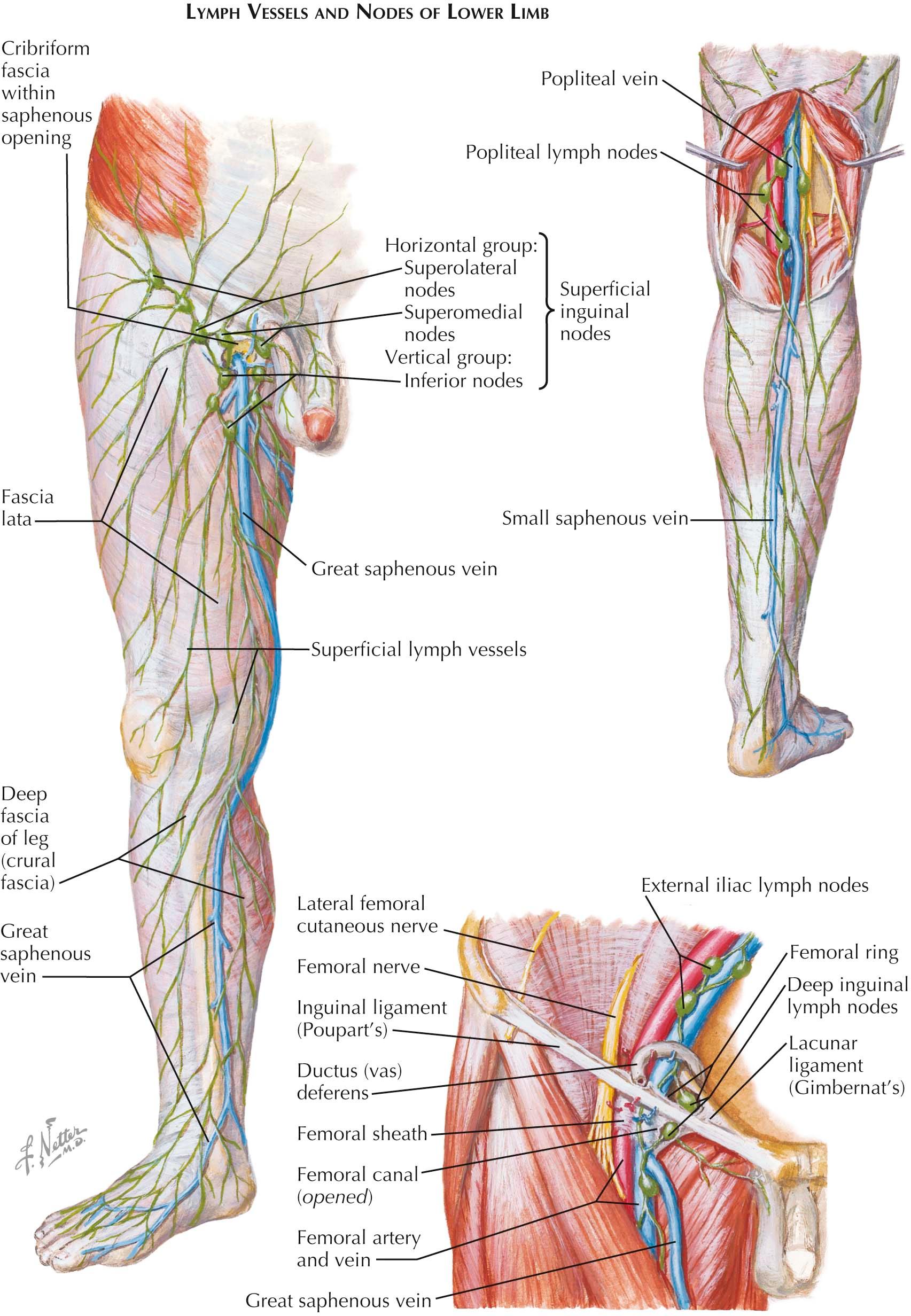
These vessels, which have a similar arrangement to the superficial lymphatic vessels of the hand, arise in plexuses on the plantar side of the toes and foot. Collecting vessels pass through interdigital clefts to the dorsum of the foot, to join there with collecting vessels from the dorsum of the toes. Collecting vessels from the medial and dorsal parts of the foot accompany the greater saphenous vein like those from the lateral part of the foot accompany the lesser saphenous vein.
The larger stream of ascending vessels is with the greater saphenous vein, toward which also converge vessels from the lateral and medial borders and the front and back of the leg and thigh. These ascending vessels end above in the superficial inguinal lymph nodes, to which also pass collecting vessels from the lower abdomen and perineum, scrotum and penis in the male (or the vulvar region in the female), and the gluteal region. The area of drainage of the lesser saphenous vein provides lymph vessels that accompany that vein, pierce the popliteal fascia with it, and end in the popliteal lymph nodes.
The superficial inguinal lymph nodes, 12 to 20 in number, are arranged in the form of a T in the subcutaneous tissue of the groin. Most of the nodes lie in the horizontal part of the T in a chain parallel to, and about 1 cm below, the inguinal ligament. They receive lymph from the lower abdominal wall, the buttocks, the penis and scrotum (or vulvar region in the female), and the perineum. The fewer, larger nodes of the vertical limb of the T lie along the termination of the greater saphenous vein. These nodes principally receive afferent vessels superficially from the limb below them but also from the penis and scrotum, perineum, and buttocks. The superficial inguinal lymph nodes send their efferent channels through the femoral sheath to the external iliac nodes. Only a few of these channels end in the deep inguinal nodes.
These vessels accompany the deep blood vessels of the limb. In the leg, they follow the anterior and posterior tibial and peroneal vessels to the popliteal nodes. Certain lymph vessels of the gluteal region follow the superior and inferior gluteal vessels to the internal iliac nodes. The popliteal nodes are usually small, six to seven in number, and lie in the fat of the popliteal fossa. One lies at the termination of the lesser saphenous vein and receives the lymph channels accompanying that vein. Another node usually lies between the popliteal artery and the capsule of the knee joint and is especially concerned with the lymphatic drainage of the knee. Other nodes of the popliteal group receive the channels that follow the deep blood vessels of the leg. The efferent vessels of the popliteal nodes follow the femoral vessels to the deep inguinal nodes.
The deep inguinal nodes are from one to three in number, lying on the medial side of the femoral vein. If three are present, one is usually located in the femoral canal, one at its upper end (femoral ring), and one below the junction of the greater saphenous and femoral veins. These nodes receive the deep lymphatic drainage of the lower limb, some channels from the penis (or clitoris), and a few of the efferent channels from the superficial inguinal nodes. They discharge to the external iliac nodes. Drainage from the external iliac nodes is through the common iliac and lateral lumbar lymph node groups to the thoracic duct.
Become a Clinical Tree membership for Full access and enjoy Unlimited articles
If you are a member. Log in here